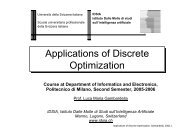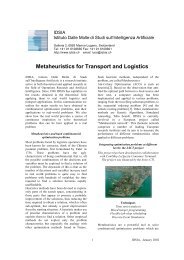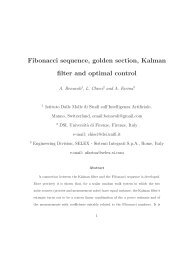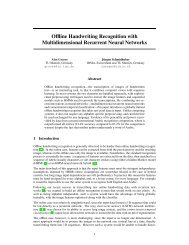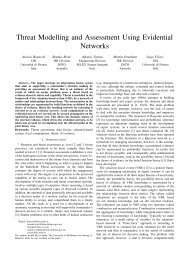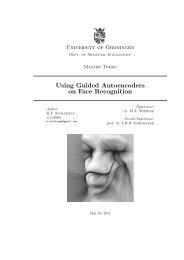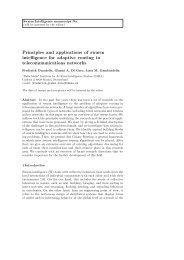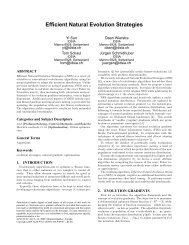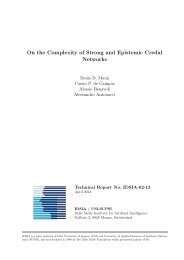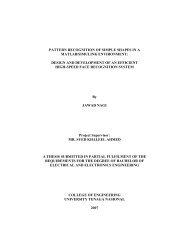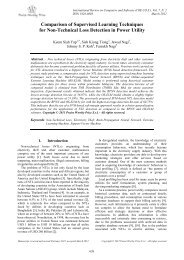AntHocNet: an Ant-Based Hybrid Routing Algorithm for ... - CiteSeerX
AntHocNet: an Ant-Based Hybrid Routing Algorithm for ... - CiteSeerX
AntHocNet: an Ant-Based Hybrid Routing Algorithm for ... - CiteSeerX
You also want an ePaper? Increase the reach of your titles
YUMPU automatically turns print PDFs into web optimized ePapers that Google loves.
<strong><strong>Ant</strong>HocNet</strong>: <strong>an</strong> <strong>Ant</strong>-<strong>Based</strong> <strong>Hybrid</strong> <strong>Routing</strong> <strong>Algorithm</strong><br />
<strong>for</strong> Mobile Ad Hoc Networks<br />
Gi<strong>an</strong>ni Di Caro, Frederick Ducatelle <strong>an</strong>d Luca Maria Gambardella<br />
Technical Report No. IDSIA-25-04-2004<br />
August 2004<br />
IDSIA / USI-SUPSI<br />
Dalle Molle Institute <strong>for</strong> Artificial Intelligence<br />
Galleria 2, 6928 M<strong>an</strong>no, Switzerl<strong>an</strong>d<br />
This report has been published on the Proceedings of Parallel Problem Solving from Nature (PPSN) VIII, LNCS 3242,<br />
pages 461–470, Springer-Verlag, 2004, Conference Best Paper Award.<br />
IDSIA is a joint institute of both University of Lug<strong>an</strong>o (USI) <strong>an</strong>d University of Applied Sciences of Southern Switzerl<strong>an</strong>d<br />
(SUPSI), <strong>an</strong>d was founded in 1988 by the Dalle Molle Foundation which promoted quality of life.
<strong><strong>Ant</strong>HocNet</strong>: <strong>an</strong> <strong>Ant</strong>-<strong>Based</strong> <strong>Hybrid</strong> <strong>Routing</strong><br />
<strong>Algorithm</strong> <strong>for</strong> Mobile Ad Hoc Networks<br />
Gi<strong>an</strong>ni Di Caro ⋆ , Frederick Ducatelle <strong>an</strong>d Luca Maria Gambardella<br />
Istituto Dalle Molle sull’Intelligenza Artificiale (IDSIA)<br />
Galleria 2, CH-6928 M<strong>an</strong>no-Lug<strong>an</strong>o, Switzerl<strong>an</strong>d<br />
{gi<strong>an</strong>ni, frederick, luca}@idsia.ch<br />
Abstract. In this paper we present <strong><strong>Ant</strong>HocNet</strong>, a new algorithm <strong>for</strong><br />
routing in mobile ad hoc networks. Due to the ever ch<strong>an</strong>ging topology<br />
<strong>an</strong>d limited b<strong>an</strong>dwidth it is very hard to establish <strong>an</strong>d maintain good<br />
routes in such networks. Especially reliability <strong>an</strong>d efficiency are import<strong>an</strong>t<br />
concerns. <strong><strong>Ant</strong>HocNet</strong> is based on ideas from <strong>Ant</strong> Colony Optimization.<br />
It consists of both reactive <strong>an</strong>d proactive components. In a reactive<br />
path setup phase, multiple paths are set up between the source <strong>an</strong>d destination<br />
of a data session, <strong>an</strong>d during the course of the communication<br />
session, <strong>an</strong>ts proactively test existing paths <strong>an</strong>d explore new ones. In<br />
simulation tests we show that <strong><strong>Ant</strong>HocNet</strong> c<strong>an</strong> outper<strong>for</strong>m AODV, one<br />
of the most import<strong>an</strong>t current state-of-the-art algorithms, both in terms<br />
of end-to-end delay <strong>an</strong>d packet delivery ratio.<br />
1 Introduction<br />
In recent years there has been <strong>an</strong> increasing interest in Mobile Ad Hoc Networks<br />
(MANETs) [13]. In this kind of networks, all nodes are mobile, <strong>an</strong>d they communicate<br />
with each other via wireless connections. There is no fixed infrastructure.<br />
All nodes are equal <strong>an</strong>d there is no centralized control or overview. There are<br />
no designated routers: all nodes c<strong>an</strong> serve as routers <strong>for</strong> each other, <strong>an</strong>d data<br />
packets are <strong>for</strong>warded from node to node in a multi-hop fashion.<br />
<strong>Routing</strong> is the task of directing data flow from source to destination maximizing<br />
network per<strong>for</strong>m<strong>an</strong>ce. This is particularly difficult in MANETs. Due to<br />
the mobility of the nodes, the topology of the network ch<strong>an</strong>ges const<strong>an</strong>tly, <strong>an</strong>d<br />
paths which were initially efficient c<strong>an</strong> quickly become inefficient or even infeasible.<br />
This me<strong>an</strong>s that routing in<strong>for</strong>mation should be updated more regularly<br />
th<strong>an</strong> in wired networks, so that in principle more routing control packets are<br />
needed. However, this is a problem in MANETs, since the b<strong>an</strong>dwidth of the<br />
wireless medium is very limited, <strong>an</strong>d the medium is shared: nodes c<strong>an</strong> only send<br />
or receive data if no other node is sending in their neighborhood. The access<br />
⋆ Corresponding author. This work was partially supported by the Future & Emerging<br />
Technologies unit of the Europe<strong>an</strong> Commission through project “BISON: Biology-<br />
Inspired techniques <strong>for</strong> Self Org<strong>an</strong>ization in dynamic Networks” (IST-2001-38923)<br />
<strong>an</strong>d by the Hasler Foundation through gr<strong>an</strong>t DICS-1830.
to the shared ch<strong>an</strong>nel is controlled by protocols at the Medium Access Control<br />
layer (MAC), such as ANSI/IEEE 802.11 DCF [7] (the most commonly used in<br />
MANETs), which in their turn create extra overhead.<br />
In this work we propose <strong><strong>Ant</strong>HocNet</strong>, a new MANET routing algorithm based<br />
on ideas from <strong>an</strong>t-based routing. For wired networks, a number of successful<br />
<strong>an</strong>t-based routing algorithms exist (eg. ABC [14] <strong>an</strong>d <strong>Ant</strong>Net [3]). They are<br />
based on the pheromone trail laying-following behavior of real <strong>an</strong>ts <strong>an</strong>d the<br />
related framework of <strong>an</strong>t colony optimization (ACO) [4]. The main idea is to<br />
continuously sample possible paths with <strong>an</strong>t-like agents, <strong>an</strong>d to indicate the<br />
quality of paths by me<strong>an</strong>s of artificial pheromone variables. Multiple paths are<br />
made available this way, <strong>an</strong>d data packets are stochastically spread over them<br />
following the pheromone values. <strong>Ant</strong>-based routing algorithms exhibit a number<br />
of desirable properties <strong>for</strong> MANET routing: they work in a distributed way, are<br />
highly adaptive, are robust, <strong>an</strong>d provide automatic load bal<strong>an</strong>cing.<br />
In this paper, we aim to propose <strong>an</strong> algorithm which c<strong>an</strong> work efficiently in<br />
MANETs, while still maintaining those properties which make <strong>an</strong>t-based algorithms<br />
so appealing. The rest of this paper is org<strong>an</strong>ized as follows. In section 2<br />
we describe related work in MANET <strong>an</strong>d <strong>an</strong>t-based routing. Section 3 contains<br />
the description of our algorithm <strong>an</strong>d in section 4 we present simulation results.<br />
2 Related work: MANET routing <strong>an</strong>d <strong>an</strong>t-based routing<br />
The specific challenges <strong>an</strong>d possible applications of MANETs have made this a<br />
very popular research area, <strong>an</strong>d a lot of routing algorithms have been proposed.<br />
People traditionally classify these algorithms as either proactive or reactive. In<br />
purely proactive protocols (e.g., DSDV [11]) nodes try to maintain at all times<br />
routes to all other nodes. This me<strong>an</strong>s that they need to keep track of all topology<br />
ch<strong>an</strong>ges, which c<strong>an</strong> become difficult if there are a lot of nodes or if they are very<br />
mobile. There<strong>for</strong>e, reactive protocols (e.g., AODV [12] or DSR [8]) are in general<br />
more scalable (see [2]). In these protocols, nodes only gather routing in<strong>for</strong>mation<br />
on dem<strong>an</strong>d: only when they have data <strong>for</strong> a certain destination they construct<br />
a path, <strong>an</strong>d only when the path becomes infeasible they search a new path.<br />
In this way they greatly reduce the routing overhead, but they c<strong>an</strong> suffer from<br />
oscillations in per<strong>for</strong>m<strong>an</strong>ce since they are never prepared <strong>for</strong> disruptive events.<br />
<strong>Hybrid</strong> algorithms like ZRP [6] have both a proactive <strong>an</strong>d a reactive component,<br />
in order to try to combine the best of both worlds.<br />
Most of the algorithms are single path: at <strong>an</strong>y time, they use only one path<br />
between source <strong>an</strong>d destination. Multipath routing (see [10] <strong>for</strong> <strong>an</strong> overview)<br />
offers <strong>an</strong> interesting alternative in terms of link failure robustness <strong>an</strong>d load bal<strong>an</strong>cing.<br />
Some algorithms create multiple paths at path setup time, <strong>an</strong>d use the<br />
best of these until it fails, after which they switch to the second best <strong>an</strong>d so<br />
on (e.g., AODV-BR [9]). A problem with this way of working is that alternative<br />
paths are often infeasible by the time they need to be used. Moreover, when only<br />
the best path is used, one looses the opportunity to spread data packets over<br />
the different paths, a practice which c<strong>an</strong> improve the network throughput.<br />
2
The first <strong>an</strong>t-based routing algorithms were ABC [14] <strong>an</strong>d <strong>Ant</strong>Net [3]. Both<br />
algorithms follow a similar general strategy. Nodes send <strong>an</strong>t agents out at regular<br />
intervals to r<strong>an</strong>domly chosen destinations. The main aim of the <strong>an</strong>ts is to<br />
sample the paths, assign a quality to them, <strong>an</strong>d use this in<strong>for</strong>mation to update<br />
the routing tables in the nodes they pass. These routing tables contain <strong>an</strong> entry<br />
<strong>for</strong> each destination <strong>an</strong>d each neighbor, indicating the goodness of going<br />
over this neighbor on the way to the destination. This goodness value is called<br />
pheromone. This pheromone in<strong>for</strong>mation is used <strong>for</strong> the routing of both <strong>an</strong>ts<br />
<strong>an</strong>d data packets: all packets are routed stochastically, choosing with a higher<br />
probability those links with higher pheromone values. If enough <strong>an</strong>ts are sent<br />
to the different destinations, nodes keep up-to-date in<strong>for</strong>mation about the best<br />
paths, <strong>an</strong>d automatically adapt their data load spreading to this.<br />
<strong>Ant</strong>-based routing algorithms have a number of properties which are desirable<br />
in MANETs: they are highly adaptive to network ch<strong>an</strong>ges, use active<br />
path sampling, are robust to agent failures, provide multipath routing, <strong>an</strong>d take<br />
care of data load spreading. However, the fact that they crucially rely on repeated<br />
path sampling c<strong>an</strong> cause signific<strong>an</strong>t overhead if not dealt with carefully.<br />
There have been a number of attempts to design <strong>an</strong>t-based routing algorithms<br />
<strong>for</strong> MANETs. Examples are ARA [5] <strong>an</strong>d PERA [1]. However, these algorithms<br />
loose much of the proactive sampling <strong>an</strong>d exploratory behavior of the original<br />
<strong>an</strong>t-based algorithms in their attempt to limit the overhead caused by the <strong>an</strong>ts.<br />
3 <strong><strong>Ant</strong>HocNet</strong><br />
<strong><strong>Ant</strong>HocNet</strong> is a hybrid multipath algorithm. When a data session is started at<br />
node s with destination d, s checks whether it has up-to-date routing in<strong>for</strong>mation<br />
<strong>for</strong> d. If not, it reactively sends out <strong>an</strong>t-like agents, called reactive <strong>for</strong>ward <strong>an</strong>ts,<br />
to look <strong>for</strong> paths to d. These <strong>an</strong>ts gather in<strong>for</strong>mation about the quality of the<br />
path they followed, <strong>an</strong>d at their arrival in d they become backward <strong>an</strong>ts which<br />
trace back the path <strong>an</strong>d update routing tables. The routing table T i in node i<br />
contains <strong>for</strong> each destination d <strong>an</strong>d each possible next hop n a value Tnd i ∈ IR. T nd<br />
i<br />
is <strong>an</strong> estimate of the goodness of the path over n to d, which we call pheromone.<br />
In this way, pheromone tables in different nodes indicate multiple paths between<br />
s <strong>an</strong>d d, <strong>an</strong>d data packets c<strong>an</strong> be routed from node to node as datagrams. They<br />
are stochastically spread over the paths: in each node they select the next hop<br />
with a probability proportional to its pheromone value. Once paths are set up<br />
<strong>an</strong>d the data session is running, s starts to send proactive <strong>for</strong>ward <strong>an</strong>ts to d.<br />
These <strong>an</strong>ts follow the pheromone values similarly to data packets. In this way<br />
they c<strong>an</strong> monitor the quality of the paths in use. Moreover, they have a small<br />
probability of being broadcasted, so that they c<strong>an</strong> also explore new paths. In<br />
case of link failures, nodes either try to locally repair paths, or send a warning<br />
to their neighbors such that these c<strong>an</strong> update their routing tables. In the rest of<br />
this section we describe each of these functions in detail.<br />
3
3.1 Reactive path setup<br />
Reactive <strong>for</strong>ward <strong>an</strong>ts looking <strong>for</strong> a destination d are either broadcasted or unicasted,<br />
according to whether or not the node they are currently in has routing<br />
in<strong>for</strong>mation <strong>for</strong> d. Due to the broadcasting, <strong>an</strong>ts c<strong>an</strong> proliferate quickly over the<br />
network, following different paths to the destination. When a node receives several<br />
<strong>an</strong>ts of the same generation (i.e., they started as the same original <strong>for</strong>ward<br />
<strong>an</strong>t at the source), it will compare the path travelled by the <strong>an</strong>t to that of the<br />
previously received <strong>an</strong>ts of this generation: only if its number of hops <strong>an</strong>d travel<br />
time are both within a certain factor (a parameter which we empirically set to<br />
1.5) of that of the best <strong>an</strong>t of the generation, it will <strong>for</strong>ward the <strong>an</strong>t. Using this<br />
policy, overhead is limited by removing <strong>an</strong>ts which follow bad paths, while the<br />
possibility to find multiple good paths is not hindered.<br />
The main task of the reactive <strong>for</strong>ward <strong>an</strong>t is to find a path connecting s <strong>an</strong>d<br />
d. It keeps a list P of the nodes [1, . . . , n] it has visited. Upon arrival at the<br />
destination d, the <strong>for</strong>ward <strong>an</strong>t is converted into a backward <strong>an</strong>t, which travels<br />
back to the source retracing P. The backward <strong>an</strong>t incrementally computes <strong>an</strong><br />
estimate ˆT P of the time it would take a data packet to travel over P towards<br />
the destination, which is used to update routing tables. ˆTP is the sum of local<br />
estimates ˆT i→i+1 in each node i ∈ P of the time to reach the next hop i + 1:<br />
ˆT P = ∑ n−1 ˆT i=1 i→i+1 . The value of ˆTi→i+1 is defined as (Q i mac + 1) ˆT mac: i the<br />
product of the estimate of the average time to send one packet, ˆT mac, i times the<br />
current number of packets in queue (plus one) to be sent at the MAC layer,<br />
Q i mac. ˆT mac i is calculated as a running average of the time elapsed between the<br />
arrival of a packet at the MAC layer <strong>an</strong>d the end of a successful tr<strong>an</strong>smission.<br />
So if t i mac is the time it took to send a packet from node i, then node i updates<br />
its estimate as follows: ˆT mac i = α ˆT mac i + (1 − α)t i mac with α ∈ [0, 1]. Since ˆT mac<br />
i<br />
is calculated at the MAC layer it includes ch<strong>an</strong>nel access activities, so it takes<br />
into account local congestion of the shared medium. Forward <strong>an</strong>ts calculate a<br />
similar time estimate, which is used <strong>for</strong> filtering the <strong>an</strong>ts, as mentioned above.<br />
At each intermediate node i ∈ P, the backward <strong>an</strong>t virtually sets up a path<br />
towards the destination d, creating or updating routing table entries Tnd i . Upon<br />
arrival in a node i from its neighbor n, the <strong>an</strong>t creates <strong>an</strong> entry in the routing<br />
table T i , indicating n as next hop to take from this node in order to reach d.<br />
The entry will contain a pheromone value Tnd i , which is <strong>an</strong> indication of the<br />
goodness of the path going to destination d over next hop n. The pheromone<br />
value represents <strong>an</strong> average of the inverse of the cost, in terms of both estimated<br />
time <strong>an</strong>d number of hops, to travel to d through n. If ˆTi→d is the travelling<br />
time estimated by the <strong>an</strong>t, <strong>an</strong>d h is the number of hops, the pheromone value is<br />
defined as: τ id = ( ( ˆT s→d + hT hop )/2 ) −1<br />
, where Thop is a fixed value representing<br />
the time of taking one hop in unloaded conditions. Taking this average is a way<br />
to avoid possibly large oscillations in the time estimates gathered by the <strong>an</strong>ts<br />
(e.g., due to local bursts of traffic) <strong>an</strong>d to take into account both end-to-end<br />
delay <strong>an</strong>d number of hops. If there was already <strong>an</strong> entry Tnd i in T i , its value is<br />
updated using a weighted average: Tnd i = γT nd i + (1 − γ)τ id, γ ∈ [0, 1] (γ <strong>an</strong>d α<br />
were set to 0.7 in the experiments).<br />
4
3.2 Stochastic data routing<br />
The path setup phase described above creates a number of good paths between<br />
source <strong>an</strong>d destination, indicated in the routing tables of the nodes. Data c<strong>an</strong><br />
then be <strong>for</strong>warded between nodes according to the values of the pheromone<br />
entries. Nodes in <strong><strong>Ant</strong>HocNet</strong> <strong>for</strong>ward data stochastically. When a node has multiple<br />
next hops <strong>for</strong> the destination d of the data, it will r<strong>an</strong>domly select one of<br />
them, with the probability P nd of a next hop n assigned as the square of its<br />
pheromone: P nd =<br />
T<br />
∑<br />
2 nd<br />
i∈N T 2<br />
d id<br />
. We take the square in order to be more greedy<br />
with respect to the better paths. According to this strategy, we do not have<br />
to choose a priori how m<strong>an</strong>y paths to use: their number will be automatically<br />
selected in function of their quality.<br />
The probabilistic routing strategy leads to data load spreading with consequent<br />
automatic load bal<strong>an</strong>cing. When a path is clearly worse th<strong>an</strong> others, it will<br />
be avoided, <strong>an</strong>d its congestion will be relieved. Other paths will get more traffic,<br />
leading to higher congestion, which will make their end-to-end delay increase.<br />
By continuously adapting the data traffic, the nodes try to spread the data load<br />
evenly over the network. This is quite import<strong>an</strong>t in MANETs, because the b<strong>an</strong>dwidth<br />
of the wireless ch<strong>an</strong>nel is very limited. Of course, to do this properly, it is<br />
import<strong>an</strong>t to frequently monitor the quality of the different paths. To this end<br />
we use the proactive <strong>an</strong>ts.<br />
3.3 Proactive path mainten<strong>an</strong>ce <strong>an</strong>d exploration<br />
While a data session is running, the source node sends out proactive <strong>for</strong>ward <strong>an</strong>ts<br />
according to the data sending rate (one <strong>an</strong>t every n th data packet). They follow<br />
the pheromone values in the same way as the data (although the pheromone<br />
values are not squared, so that they sample the paths more evenly), but have a<br />
small probability at each node of being broadcasted. In this way they serve two<br />
purposes. If a <strong>for</strong>ward <strong>an</strong>t reaches the destination without a single broadcast<br />
it simply samples <strong>an</strong> existing path. It gathers up-to-date quality estimates of<br />
this path, <strong>an</strong>d updates the pheromone values along the path from source to<br />
destination. A backward <strong>an</strong>t does the same <strong>for</strong> the direction from the destination<br />
back to the source. If on the other h<strong>an</strong>d the <strong>an</strong>t got broadcasted at <strong>an</strong>y point,<br />
it will leave the currently known pheromone trails, <strong>an</strong>d explore new paths.<br />
After a broadcast the <strong>an</strong>t will arrive in all the neighbors of the broadcasting<br />
node. It is possible that in this neighbor it does not find pheromone pointing<br />
towards the destination, so that it will need to be broadcasted again. The <strong>an</strong>t will<br />
then quickly proliferate <strong>an</strong>d flood the network, like a reactive <strong>for</strong>ward <strong>an</strong>t does.<br />
In order to avoid this, we limit the number of broadcasts to two. If the proactive<br />
<strong>an</strong>t does not find routing in<strong>for</strong>mation within two hops, it will be deleted. The<br />
effect of this mech<strong>an</strong>ism is that the search <strong>for</strong> new paths is concentrated around<br />
the current paths, so that we are looking <strong>for</strong> path improvements <strong>an</strong>d variations.<br />
5
In order to guide the <strong>for</strong>ward <strong>an</strong>ts a bit better, we use hello messages 1 :<br />
using these messages, nodes know about their immediate neighbors <strong>an</strong>d have<br />
pheromone in<strong>for</strong>mation about them in their routing table. So when <strong>an</strong> <strong>an</strong>t arrives<br />
in a neighbor of the destination, it c<strong>an</strong> go straight to its goal. Looking<br />
back at the <strong>an</strong>t colony inspiration of our model, this c<strong>an</strong> be seen as pheromone<br />
diffusion: pheromone deposited on the ground diffuses, <strong>an</strong>d c<strong>an</strong> be detected also<br />
by <strong>an</strong>ts further away. In future work we will extend this concept, to give better<br />
guid<strong>an</strong>ce to the exploration by the proactive <strong>an</strong>ts. Hello messages also serve <strong>an</strong>other<br />
purpose: they allow to detect broken links. This allow nodes to cle<strong>an</strong> up<br />
stale pheromone entries from their routing tables.<br />
3.4 Link failures<br />
Nodes c<strong>an</strong> detect link failures (e.g., a neighbor has moved far away) when unicast<br />
tr<strong>an</strong>smissions (of data packets or <strong>an</strong>ts) fail, or when expected hello messages<br />
were not received. When a link fails, a node might loose a path to one or more<br />
destinations. If the node has other next hop alternatives to the same destination,<br />
or if the lost destination was not used regularly by data, this loss is not so<br />
import<strong>an</strong>t, <strong>an</strong>d the node will just update its routing table <strong>an</strong>d send a notification<br />
of the update to its neighbors. On the other h<strong>an</strong>d, if the destination was regularly<br />
used <strong>for</strong> data traffic, <strong>an</strong>d it was the node’s only alternative <strong>for</strong> this destination,<br />
the loss is import<strong>an</strong>t <strong>an</strong>d the node should try to repair the path. This is the<br />
strategy followed in <strong><strong>Ant</strong>HocNet</strong>, with the restriction that a node only repairs<br />
the path if the link loss was discovered with a failed data packet tr<strong>an</strong>smission.<br />
After the link failure, the node broadcasts a route repair <strong>an</strong>t that travels to<br />
the involved destination like a reactive <strong>for</strong>ward <strong>an</strong>t: it follows available routing<br />
in<strong>for</strong>mation when it c<strong>an</strong>, <strong>an</strong>d is broadcasted otherwise. One import<strong>an</strong>t difference<br />
is that it has a maximum number of broadcasts (which we set to 2 in our experiments),<br />
so that its proliferation is limited. The node waits <strong>for</strong> a certain time<br />
(empirically set to 5 times the estimated end-to-end of the lost path), <strong>an</strong>d if no<br />
backward repair <strong>an</strong>t is received, it concludes that it was not possible to find <strong>an</strong><br />
alternative path to the destination which is removed from the routing table.<br />
In the case the node still has other entries <strong>for</strong> the destination(s) involved in a<br />
link failure, but the lost next hop was its best alternative <strong>for</strong> the destination, or<br />
if the link failure was due to <strong>an</strong> <strong>an</strong>t packet, the node will only send a notification<br />
to its neighbors. Also in the case of a failed path repair it will send a similar<br />
notification. The notification contains a list of the destinations it lost a path<br />
to, <strong>an</strong>d the new best estimated end-to-end delay <strong>an</strong>d number of hops to this<br />
destination (if it still has entries <strong>for</strong> the destination). All its neighbors receive<br />
the notification <strong>an</strong>d update their pheromone table using the new estimates. If<br />
1 Hello messages are short messages broadcasted every t hello seconds (e.g., t hello =<br />
1sec) by the nodes. If a node receives a hello message from a new node n, it will add<br />
n as a new destination in its routing table. After that it expects to receive a hello<br />
from n every t hello seconds. After missing a certain number of expected hello’s (2 in<br />
our case), n will be removed.<br />
6
they in turn lost their best or their only path to a destination due to the failure,<br />
they will broadcast the notification further, until all nodes along the different<br />
paths are notified of the new situation.<br />
4 Simulation Experiments<br />
We evaluate our algorithm in a number of simulation tests. We compare its<br />
per<strong>for</strong>m<strong>an</strong>ce with AODV [12] (with route repair), a state-of-the-art MANET<br />
routing algorithm <strong>an</strong>d a de facto st<strong>an</strong>dard. In 4.1 we describe the simulation<br />
environment <strong>an</strong>d the test scenarios, <strong>an</strong>d in 4.2 we show <strong>an</strong>d discuss the results.<br />
4.1 Simulation Environment<br />
As simulation software we used Qualnet, a discrete-event simulator developed by<br />
Scalable Networks as a follow-up of GloMoSim, which was designed by UCLA.<br />
Qualnet is specifically optimized to simulate large-scale MANETs, <strong>an</strong>d comes<br />
with correct implementations of the most import<strong>an</strong>t routing protocols.<br />
All our simulation scenarios are derived from the base scenario used in [2],<br />
which is <strong>an</strong> import<strong>an</strong>t reference. In this base scenario 50 nodes are r<strong>an</strong>domly<br />
placed in <strong>an</strong> area of 1500 × 300 m 2 . The area is rect<strong>an</strong>gular in order to have<br />
more long paths. Within this area, the nodes move according to the r<strong>an</strong>dom<br />
waypoint model [8]: each node r<strong>an</strong>domly chooses a destination point <strong>an</strong>d a speed,<br />
<strong>an</strong>d moves to this point with the chosen speed. After that it stops <strong>for</strong> a certain<br />
pause time <strong>an</strong>d then chooses a new destination <strong>an</strong>d speed. The maximum speed<br />
in the scenario is 20m/s <strong>an</strong>d the pause time is 30 seconds. The total length of<br />
the simulation is 900 seconds. Data traffic is generated by 20 const<strong>an</strong>t bit rate<br />
(CBR) sources sending one 64-byte packet per second. Each source starts sending<br />
at a r<strong>an</strong>dom time between 0 <strong>an</strong>d 180 seconds after the start of the simulation,<br />
<strong>an</strong>d keeps sending until the end. At the physical layer we use a two-ray signal<br />
propagation model. The tr<strong>an</strong>smission r<strong>an</strong>ge is 300 meters, <strong>an</strong>d the data rate is<br />
2Mbit/s. At the MAC layer we use the popular 802.11 DCF protocol.<br />
The different test scenarios used below were derived from the base scenario<br />
by ch<strong>an</strong>ging some of the parameters. In particular, we varied the pause time,<br />
the area dimensions <strong>an</strong>d the number of nodes. For each new scenario, 5 different<br />
problems were created, by choosing different initial placements of the nodes <strong>an</strong>d<br />
different movement patterns. The reported results are averaged over 5 different<br />
runs (to account <strong>for</strong> stochastic elements, both in the algorithms <strong>an</strong>d in the<br />
physical <strong>an</strong>d MAC layers) on each of the 5 problems.<br />
4.2 Simulation Results<br />
In a first set of experiments we progressively extended the long side of the simulation<br />
area. This has a double effect: paths become longer <strong>an</strong>d the network<br />
becomes sparser. The results are shown in figure 1. In the base scenario, <strong><strong>Ant</strong>HocNet</strong><br />
has a better delivery ratio th<strong>an</strong> AODV, but a higher average delay.<br />
7
For the longer areas, the difference in delivery ratio becomes bigger, <strong>an</strong>d AODV<br />
also looses its adv<strong>an</strong>tage in delay. If we take a look at the 99 th percentile of the<br />
delay, we c<strong>an</strong> see that the decrease in per<strong>for</strong>m<strong>an</strong>ce of AODV is mainly due to a<br />
small number of packets with very high delay. This me<strong>an</strong>s that AODV delivers<br />
packets with a very high delay jitter, a crucial problem in terms of quality of<br />
service (QoS). The jitter could be reduced by removing these packets with very<br />
high delay, but that would me<strong>an</strong> <strong>an</strong> even worse delivery ratio <strong>for</strong> AODV. Next<br />
0.98<br />
0.96<br />
0.94<br />
<strong><strong>Ant</strong>HocNet</strong><br />
AODV<br />
1.2<br />
1<br />
0.8<br />
<strong><strong>Ant</strong>HocNet</strong><br />
<strong><strong>Ant</strong>HocNet</strong> 99%<br />
AODV<br />
AODV 99%<br />
0.92<br />
0.9<br />
0.6<br />
0.88<br />
0.4<br />
0.86<br />
0.2<br />
0.84<br />
1600 1800 2000 2200 2400<br />
0<br />
1600 1800 2000 2200 2400<br />
Fig. 1. On the left the delivery ratio (the fraction of sent packets which actually arrives<br />
at their destination) <strong>an</strong>d on the right the average <strong>an</strong>d the 99 th percentile of the delay<br />
per packet. On x-axis the long edge of the area: starting from the base scenario of<br />
1500 × 300 m 2 , <strong>an</strong>d ending at 2500 × 300 m 2 .<br />
we ch<strong>an</strong>ged the mobility of the nodes, varying the pause time between 0 seconds<br />
(all nodes move const<strong>an</strong>tly) <strong>an</strong>d 900 seconds (all nodes are static). The area<br />
dimensions were kept on 2500 × 300 m 2 , like at the end of the previous experiment<br />
(results <strong>for</strong> 1500 × 300 m 2 were similar but less pronounced). In figure<br />
2 we c<strong>an</strong> see a similar trend as in the previous experiment. For easy situations<br />
(long pause times, hardly <strong>an</strong>y mobility), <strong><strong>Ant</strong>HocNet</strong> has a higher delivery ratio,<br />
while AODV has lower delay. As the environment becomes more difficult (high<br />
mobility), the difference in delivery ratio becomes bigger, while the average delay<br />
of <strong><strong>Ant</strong>HocNet</strong> becomes better th<strong>an</strong> that of AODV. Again, the 99 th percentile of<br />
AODV shows that this algorithm delivers some packets with a very high delay.<br />
Also <strong><strong>Ant</strong>HocNet</strong> has some packets with a high delay (since the average is above<br />
the 99 th percentile), but this number is less th<strong>an</strong> 1% of the packets. In a last<br />
experiment we increased the scale of the problem. Starting from 50 nodes in a<br />
1500 × 500 m 2 area, we multiply both terrain edges by a scaling factor <strong>an</strong>d the<br />
number of nodes by the square of this factor, up to 200 nodes in a 3000×1000 m 2<br />
area. The results, presented in figure 3, show again the same trend: as the problem<br />
gets more difficult, the adv<strong>an</strong>tage of <strong><strong>Ant</strong>HocNet</strong> in terms of delivery ratio<br />
increases, while the adv<strong>an</strong>tage of AODV in terms of average delay becomes a<br />
disadv<strong>an</strong>tage. Again this is due to a number of packets with a very high delay.<br />
The experiments described above show that <strong><strong>Ant</strong>HocNet</strong> has some clear adv<strong>an</strong>tages<br />
over AODV. First of all, <strong><strong>Ant</strong>HocNet</strong> gave a better delivery ratio th<strong>an</strong><br />
AODV in all scenarios. The construction of multiple paths at route setup, <strong>an</strong>d<br />
8
1<br />
0.98<br />
0.96<br />
0.94<br />
0.92<br />
0.9<br />
0.88<br />
0.86<br />
<strong><strong>Ant</strong>HocNet</strong><br />
AODV<br />
0.16<br />
0.14<br />
0.12<br />
0.1<br />
0.08<br />
0.06<br />
0.04<br />
<strong><strong>Ant</strong>HocNet</strong><br />
<strong><strong>Ant</strong>HocNet</strong> 99%<br />
AODV<br />
AODV 99%<br />
0.84<br />
0.02<br />
0.82<br />
0 100 200 300 400 500 600 700 800 900<br />
0<br />
0 100 200 300 400 500 600 700 800 900<br />
Fig. 2. On the left the delivery ratio <strong>an</strong>d on the right the average <strong>an</strong>d 99 th percentile<br />
of the delay. On the x-axis the node pause time in seconds.<br />
0.98<br />
0.96<br />
0.94<br />
0.92<br />
0.9<br />
0.88<br />
0.86<br />
0.84<br />
<strong><strong>Ant</strong>HocNet</strong><br />
AODV<br />
0.16<br />
0.14<br />
0.12<br />
0.1<br />
0.08<br />
0.06<br />
0.04<br />
<strong><strong>Ant</strong>HocNet</strong><br />
<strong><strong>Ant</strong>HocNet</strong> 99%<br />
AODV<br />
AODV 99%<br />
0.82<br />
0.02<br />
0.8<br />
1 1.2 1.4 1.6 1.8 2<br />
0<br />
1 1.2 1.4 1.6 1.8 2<br />
Fig. 3. On the left the delivery ratio <strong>an</strong>d on the right the average <strong>an</strong>d 99 th percentile<br />
of the delay. On the x-axis the scaling factor <strong>for</strong> the problem.<br />
the continuous search <strong>for</strong> new paths with proactive <strong>an</strong>ts ensures that there are<br />
often alternative paths available in case of route failures, resulting in less packet<br />
loss. Second, <strong><strong>Ant</strong>HocNet</strong> has a higher average delay th<strong>an</strong> AODV <strong>for</strong> the simpler<br />
scenarios, but a lower average delay <strong>for</strong> the more difficult ones. The average<br />
delay of AODV increases sharply in each of the difficult scenarios, <strong>an</strong>d the 99 th<br />
percentile figures indicate that this is mainly due to a fraction of packets which<br />
is delivered with <strong>an</strong> abnormally high delay. Moreover, the 95 th percentile (not<br />
shown in the figures) is usually lower <strong>for</strong> AODV th<strong>an</strong> <strong>for</strong> <strong><strong>Ant</strong>HocNet</strong>, indicating<br />
that AODV still delivers most of its packets faster th<strong>an</strong> <strong><strong>Ant</strong>HocNet</strong>. This is in<br />
line with the multipath nature of <strong><strong>Ant</strong>HocNet</strong>: since it uses different paths simult<strong>an</strong>eously,<br />
not all packets are sent over the shortest path, <strong>an</strong>d so the average<br />
delay will be slightly higher. On the other h<strong>an</strong>d, since AODV relies on just one<br />
path, delays c<strong>an</strong> become very bad when this path becomes inefficient or invalid.<br />
This is especially likely to happen in difficult scenarios, with longer paths, lower<br />
node density or higher mobility, rather th<strong>an</strong> in the dense <strong>an</strong>d relatively easy base<br />
scenario. Delivering packets with low variability <strong>an</strong>d low maximum delay is <strong>an</strong><br />
import<strong>an</strong>t factor in QoS routing.<br />
9
5 Conclusions <strong>an</strong>d future work<br />
We have presented <strong><strong>Ant</strong>HocNet</strong>, a new <strong>an</strong>t-based algorithm <strong>for</strong> routing in MANETs.<br />
It is a hybrid algorithm, combining reactive route setup with proactive route<br />
probing <strong>an</strong>d exploration. In simulation experiments we show that <strong><strong>Ant</strong>HocNet</strong><br />
c<strong>an</strong> outper<strong>for</strong>m AODV in terms of delivery ratio <strong>an</strong>d average delay, especially in<br />
difficult scenarios. Also in terms of delay jitter, <strong><strong>Ant</strong>HocNet</strong> shows better results.<br />
In future work we w<strong>an</strong>t to improve the exploratory working of proactive<br />
<strong>an</strong>ts. By extending the concept of pheromone diffusion, more in<strong>for</strong>mation about<br />
possible path improvements will be available in the nodes, <strong>an</strong>d this in<strong>for</strong>mation<br />
c<strong>an</strong> guide proactive <strong>an</strong>ts. This should lead to better results with less overhead.<br />
Also, we would like to try out a virtual circuit based approach. This could result<br />
in better control over paths, so that data delivery c<strong>an</strong> be made more reliable.<br />
References<br />
1. J. S. Baras <strong>an</strong>d H. Mehta. A probabilistic emergent routing algorithm <strong>for</strong> mobile<br />
ad hoc networks. In WiOpt03: Modeling <strong>an</strong>d Optimization in Mobile, Ad Hoc <strong>an</strong>d<br />
Wireless Networks, 2003.<br />
2. J. Broch, D. Maltz, D. Johnson, Y.-C. Hu, <strong>an</strong>d J. Jetcheva. A per<strong>for</strong>m<strong>an</strong>ce comparison<br />
of multi-hop wireless ad hoc network routing protocols. In Proc. of 4th<br />
Annual ACM/IEEE Int. Conf. on Mobile Computing <strong>an</strong>d Networking, 1998.<br />
3. G. Di Caro <strong>an</strong>d M. Dorigo. <strong>Ant</strong>Net: Distributed stigmergic control <strong>for</strong> communications<br />
networks. Journal of Artificial Intelligence Research, 9:317–365, 1998.<br />
4. M. Dorigo, G. Di Caro, <strong>an</strong>d L. M. Gambardella. <strong>Ant</strong> algorithms <strong>for</strong> discrete<br />
optimization. Artificial Life, 5(2):137–172, 1999.<br />
5. M. Günes, U. Sorges, <strong>an</strong>d I. Bouazizi. ARA - the <strong>an</strong>t-colony based routing algorithm<br />
<strong>for</strong> m<strong>an</strong>ets. In Proc. of 2002 ICPP Workshop on Ad Hoc Networks, 2002.<br />
6. Z. J. Haas. A new routing protocol <strong>for</strong> the reconfigurable wireless networks. In<br />
Proc. of the IEEE Int. Conf. on Universal Personal Communications, 1997.<br />
7. IEEE 802.11 working group. ANSI/IEEE std. 802.11, 1999 edition: Wireless LAN<br />
medium access control (MAC) <strong>an</strong>d physical layer (PHY) specifications. Technical<br />
report, ANSI/IEEE, 1999.<br />
8. D. B. Johnson <strong>an</strong>d D. A. Maltz. Mobile Computing, chapter Dynamic Source<br />
<strong>Routing</strong> in Ad Hoc Wireless Networks, pages 153–181. Kluwer, 1996.<br />
9. S.-J. Lee <strong>an</strong>d M. Gerla. Aodv-br: Backup routing in ad hoc networks. In Proceedings<br />
of IEEE WCNC 2000, 2000.<br />
10. S. Mueller, R. Ts<strong>an</strong>g, <strong>an</strong>d D. Ghosal. Multipath routing in mobile ad hoc networks:<br />
Issues <strong>an</strong>d challenges. In Per<strong>for</strong>m<strong>an</strong>ce Tools <strong>an</strong>d Applications to Networked Systems,<br />
volume 2965 of Lecture Notes in Computer Science. Springer-Verlag, 2004.<br />
11. C. Perkins <strong>an</strong>d P. Bhagwat. Highly dynamic destination-sequenced dist<strong>an</strong>ce-vector<br />
routing (DSDV) <strong>for</strong> mobile computers. In ACM SIGCOMM’94 Conference on<br />
Communications Architectures, Protocols <strong>an</strong>d Applications, 1994.<br />
12. C. Perkins <strong>an</strong>d E. Royer. Ad-hoc on-dem<strong>an</strong>d dist<strong>an</strong>ce vector routing. In Proc. of<br />
2nd IEEE Workshop on Mobile Computing Systems <strong>an</strong>d Applications, 1999.<br />
13. E. M. Royer <strong>an</strong>d C.-K. Toh. A review of current routing protocols <strong>for</strong> ad hoc<br />
mobile wireless networks. IEEE Personal Communications, 1999.<br />
14. R. Schoonderwoerd, O. Holl<strong>an</strong>d, J. Bruten, <strong>an</strong>d L. Rothkr<strong>an</strong>tz. <strong>Ant</strong>-based load<br />
bal<strong>an</strong>cing in telecommunications networks. Adaptive Behavior, (2):169–207, 1996.<br />
10



